Marketing Analysis: Kellogg's and Nestle Report - Marketing Module
VerifiedAdded on 2020/07/22
|9
|2961
|481
Report
AI Summary
This report provides an introduction to marketing, exploring various techniques and their limitations within the context of two organizations, Kellogg's and Nestle. It delves into the significance of marketing research in developing effective marketing plans, including primary and secondary research methods, and the use of SWOT analysis. The report further examines market segmentation strategies, such as geographic, demographic, psychographic, and socio-cultural segmentation, to target specific customer groups. Finally, it outlines the marketing mix (product, price, place, and promotion) for a new product or service, providing a comprehensive overview of key marketing concepts and their practical application. The report also covers the consumer laws and regulations that businesses must adhere to when marketing their products.

Introduction To Marketing
Paraphrase This Document
Need a fresh take? Get an instant paraphrase of this document with our AI Paraphraser
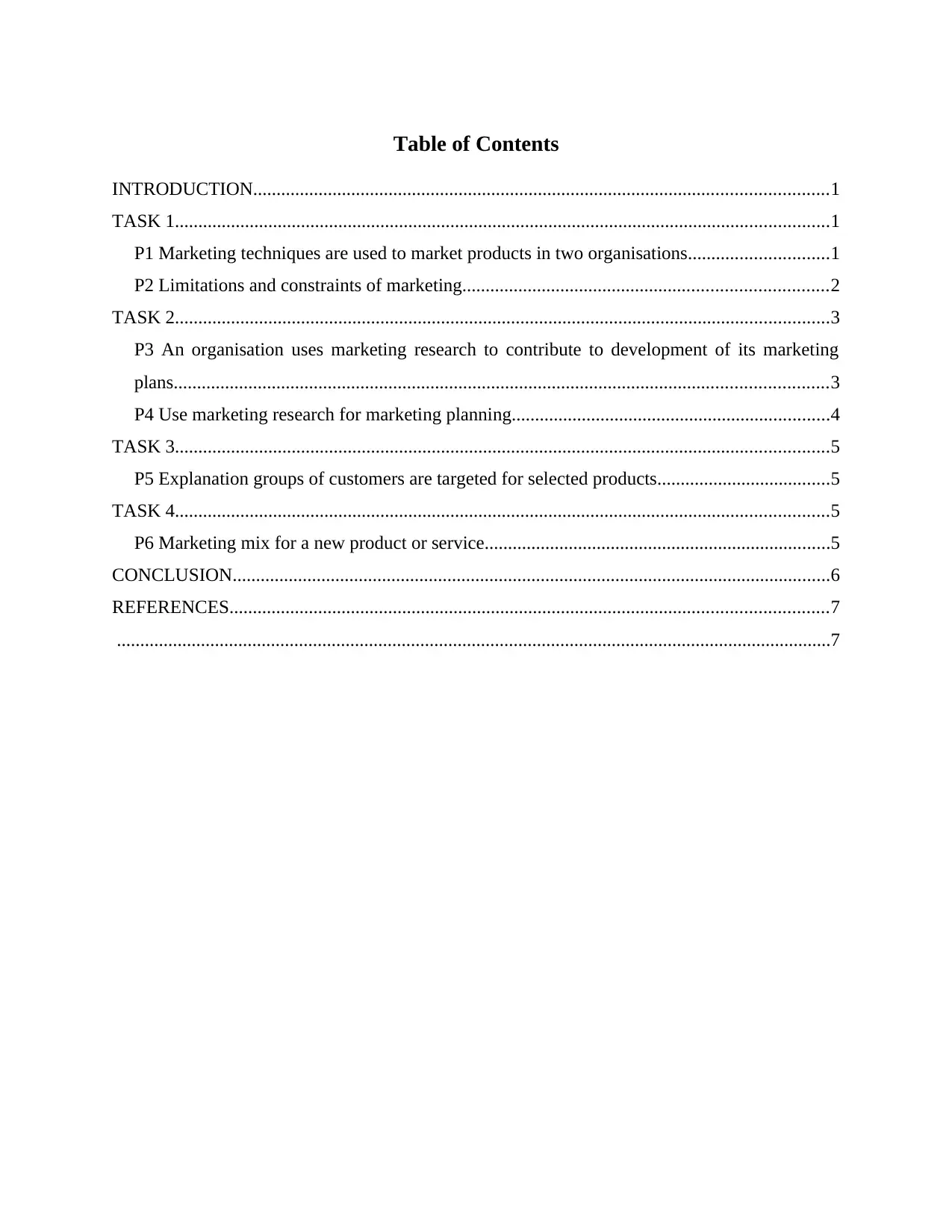
Table of Contents
INTRODUCTION...........................................................................................................................1
TASK 1............................................................................................................................................1
P1 Marketing techniques are used to market products in two organisations..............................1
P2 Limitations and constraints of marketing..............................................................................2
TASK 2............................................................................................................................................3
P3 An organisation uses marketing research to contribute to development of its marketing
plans............................................................................................................................................3
P4 Use marketing research for marketing planning....................................................................4
TASK 3............................................................................................................................................5
P5 Explanation groups of customers are targeted for selected products.....................................5
TASK 4............................................................................................................................................5
P6 Marketing mix for a new product or service..........................................................................5
CONCLUSION................................................................................................................................6
REFERENCES................................................................................................................................7
.........................................................................................................................................................7
INTRODUCTION...........................................................................................................................1
TASK 1............................................................................................................................................1
P1 Marketing techniques are used to market products in two organisations..............................1
P2 Limitations and constraints of marketing..............................................................................2
TASK 2............................................................................................................................................3
P3 An organisation uses marketing research to contribute to development of its marketing
plans............................................................................................................................................3
P4 Use marketing research for marketing planning....................................................................4
TASK 3............................................................................................................................................5
P5 Explanation groups of customers are targeted for selected products.....................................5
TASK 4............................................................................................................................................5
P6 Marketing mix for a new product or service..........................................................................5
CONCLUSION................................................................................................................................6
REFERENCES................................................................................................................................7
.........................................................................................................................................................7
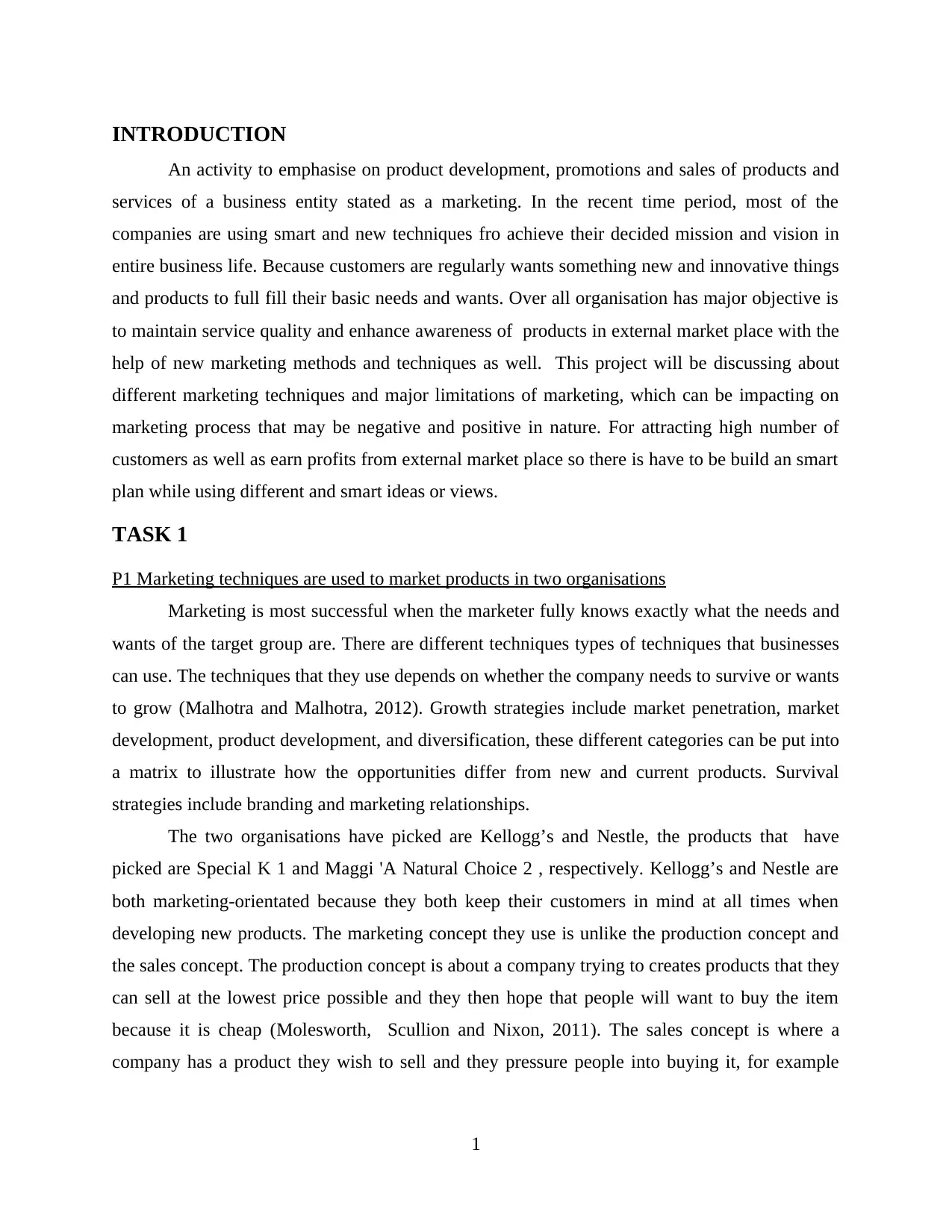
INTRODUCTION
An activity to emphasise on product development, promotions and sales of products and
services of a business entity stated as a marketing. In the recent time period, most of the
companies are using smart and new techniques fro achieve their decided mission and vision in
entire business life. Because customers are regularly wants something new and innovative things
and products to full fill their basic needs and wants. Over all organisation has major objective is
to maintain service quality and enhance awareness of products in external market place with the
help of new marketing methods and techniques as well. This project will be discussing about
different marketing techniques and major limitations of marketing, which can be impacting on
marketing process that may be negative and positive in nature. For attracting high number of
customers as well as earn profits from external market place so there is have to be build an smart
plan while using different and smart ideas or views.
TASK 1
P1 Marketing techniques are used to market products in two organisations
Marketing is most successful when the marketer fully knows exactly what the needs and
wants of the target group are. There are different techniques types of techniques that businesses
can use. The techniques that they use depends on whether the company needs to survive or wants
to grow (Malhotra and Malhotra, 2012). Growth strategies include market penetration, market
development, product development, and diversification, these different categories can be put into
a matrix to illustrate how the opportunities differ from new and current products. Survival
strategies include branding and marketing relationships.
The two organisations have picked are Kellogg’s and Nestle, the products that have
picked are Special K 1 and Maggi 'A Natural Choice 2 , respectively. Kellogg’s and Nestle are
both marketing-orientated because they both keep their customers in mind at all times when
developing new products. The marketing concept they use is unlike the production concept and
the sales concept. The production concept is about a company trying to creates products that they
can sell at the lowest price possible and they then hope that people will want to buy the item
because it is cheap (Molesworth, Scullion and Nixon, 2011). The sales concept is where a
company has a product they wish to sell and they pressure people into buying it, for example
1
An activity to emphasise on product development, promotions and sales of products and
services of a business entity stated as a marketing. In the recent time period, most of the
companies are using smart and new techniques fro achieve their decided mission and vision in
entire business life. Because customers are regularly wants something new and innovative things
and products to full fill their basic needs and wants. Over all organisation has major objective is
to maintain service quality and enhance awareness of products in external market place with the
help of new marketing methods and techniques as well. This project will be discussing about
different marketing techniques and major limitations of marketing, which can be impacting on
marketing process that may be negative and positive in nature. For attracting high number of
customers as well as earn profits from external market place so there is have to be build an smart
plan while using different and smart ideas or views.
TASK 1
P1 Marketing techniques are used to market products in two organisations
Marketing is most successful when the marketer fully knows exactly what the needs and
wants of the target group are. There are different techniques types of techniques that businesses
can use. The techniques that they use depends on whether the company needs to survive or wants
to grow (Malhotra and Malhotra, 2012). Growth strategies include market penetration, market
development, product development, and diversification, these different categories can be put into
a matrix to illustrate how the opportunities differ from new and current products. Survival
strategies include branding and marketing relationships.
The two organisations have picked are Kellogg’s and Nestle, the products that have
picked are Special K 1 and Maggi 'A Natural Choice 2 , respectively. Kellogg’s and Nestle are
both marketing-orientated because they both keep their customers in mind at all times when
developing new products. The marketing concept they use is unlike the production concept and
the sales concept. The production concept is about a company trying to creates products that they
can sell at the lowest price possible and they then hope that people will want to buy the item
because it is cheap (Molesworth, Scullion and Nixon, 2011). The sales concept is where a
company has a product they wish to sell and they pressure people into buying it, for example
1
⊘ This is a preview!⊘
Do you want full access?
Subscribe today to unlock all pages.

Trusted by 1+ million students worldwide
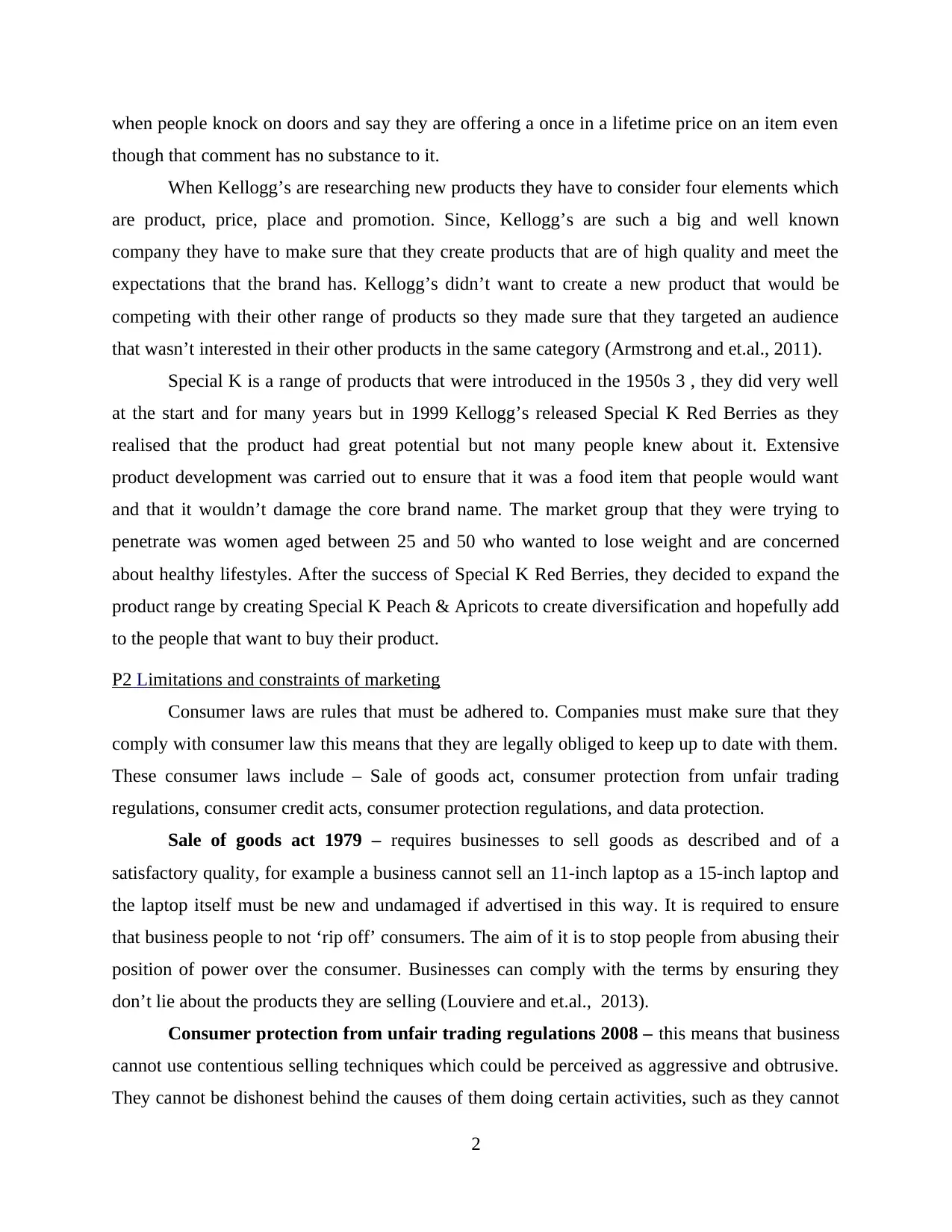
when people knock on doors and say they are offering a once in a lifetime price on an item even
though that comment has no substance to it.
When Kellogg’s are researching new products they have to consider four elements which
are product, price, place and promotion. Since, Kellogg’s are such a big and well known
company they have to make sure that they create products that are of high quality and meet the
expectations that the brand has. Kellogg’s didn’t want to create a new product that would be
competing with their other range of products so they made sure that they targeted an audience
that wasn’t interested in their other products in the same category (Armstrong and et.al., 2011).
Special K is a range of products that were introduced in the 1950s 3 , they did very well
at the start and for many years but in 1999 Kellogg’s released Special K Red Berries as they
realised that the product had great potential but not many people knew about it. Extensive
product development was carried out to ensure that it was a food item that people would want
and that it wouldn’t damage the core brand name. The market group that they were trying to
penetrate was women aged between 25 and 50 who wanted to lose weight and are concerned
about healthy lifestyles. After the success of Special K Red Berries, they decided to expand the
product range by creating Special K Peach & Apricots to create diversification and hopefully add
to the people that want to buy their product.
P2 Limitations and constraints of marketing
Consumer laws are rules that must be adhered to. Companies must make sure that they
comply with consumer law this means that they are legally obliged to keep up to date with them.
These consumer laws include – Sale of goods act, consumer protection from unfair trading
regulations, consumer credit acts, consumer protection regulations, and data protection.
Sale of goods act 1979 – requires businesses to sell goods as described and of a
satisfactory quality, for example a business cannot sell an 11-inch laptop as a 15-inch laptop and
the laptop itself must be new and undamaged if advertised in this way. It is required to ensure
that business people to not ‘rip off’ consumers. The aim of it is to stop people from abusing their
position of power over the consumer. Businesses can comply with the terms by ensuring they
don’t lie about the products they are selling (Louviere and et.al., 2013).
Consumer protection from unfair trading regulations 2008 – this means that business
cannot use contentious selling techniques which could be perceived as aggressive and obtrusive.
They cannot be dishonest behind the causes of them doing certain activities, such as they cannot
2
though that comment has no substance to it.
When Kellogg’s are researching new products they have to consider four elements which
are product, price, place and promotion. Since, Kellogg’s are such a big and well known
company they have to make sure that they create products that are of high quality and meet the
expectations that the brand has. Kellogg’s didn’t want to create a new product that would be
competing with their other range of products so they made sure that they targeted an audience
that wasn’t interested in their other products in the same category (Armstrong and et.al., 2011).
Special K is a range of products that were introduced in the 1950s 3 , they did very well
at the start and for many years but in 1999 Kellogg’s released Special K Red Berries as they
realised that the product had great potential but not many people knew about it. Extensive
product development was carried out to ensure that it was a food item that people would want
and that it wouldn’t damage the core brand name. The market group that they were trying to
penetrate was women aged between 25 and 50 who wanted to lose weight and are concerned
about healthy lifestyles. After the success of Special K Red Berries, they decided to expand the
product range by creating Special K Peach & Apricots to create diversification and hopefully add
to the people that want to buy their product.
P2 Limitations and constraints of marketing
Consumer laws are rules that must be adhered to. Companies must make sure that they
comply with consumer law this means that they are legally obliged to keep up to date with them.
These consumer laws include – Sale of goods act, consumer protection from unfair trading
regulations, consumer credit acts, consumer protection regulations, and data protection.
Sale of goods act 1979 – requires businesses to sell goods as described and of a
satisfactory quality, for example a business cannot sell an 11-inch laptop as a 15-inch laptop and
the laptop itself must be new and undamaged if advertised in this way. It is required to ensure
that business people to not ‘rip off’ consumers. The aim of it is to stop people from abusing their
position of power over the consumer. Businesses can comply with the terms by ensuring they
don’t lie about the products they are selling (Louviere and et.al., 2013).
Consumer protection from unfair trading regulations 2008 – this means that business
cannot use contentious selling techniques which could be perceived as aggressive and obtrusive.
They cannot be dishonest behind the causes of them doing certain activities, such as they cannot
2
Paraphrase This Document
Need a fresh take? Get an instant paraphrase of this document with our AI Paraphraser
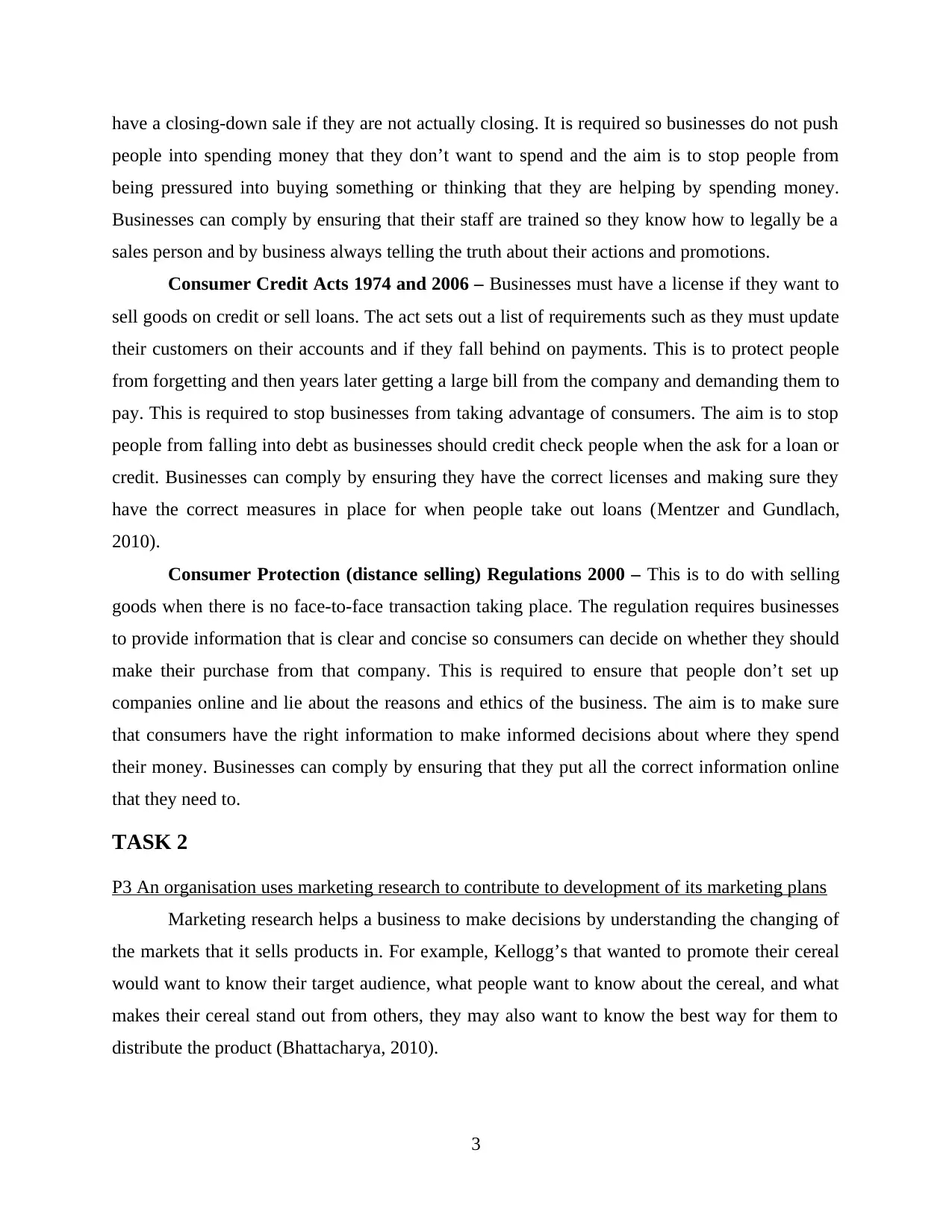
have a closing-down sale if they are not actually closing. It is required so businesses do not push
people into spending money that they don’t want to spend and the aim is to stop people from
being pressured into buying something or thinking that they are helping by spending money.
Businesses can comply by ensuring that their staff are trained so they know how to legally be a
sales person and by business always telling the truth about their actions and promotions.
Consumer Credit Acts 1974 and 2006 – Businesses must have a license if they want to
sell goods on credit or sell loans. The act sets out a list of requirements such as they must update
their customers on their accounts and if they fall behind on payments. This is to protect people
from forgetting and then years later getting a large bill from the company and demanding them to
pay. This is required to stop businesses from taking advantage of consumers. The aim is to stop
people from falling into debt as businesses should credit check people when the ask for a loan or
credit. Businesses can comply by ensuring they have the correct licenses and making sure they
have the correct measures in place for when people take out loans (Mentzer and Gundlach,
2010).
Consumer Protection (distance selling) Regulations 2000 – This is to do with selling
goods when there is no face-to-face transaction taking place. The regulation requires businesses
to provide information that is clear and concise so consumers can decide on whether they should
make their purchase from that company. This is required to ensure that people don’t set up
companies online and lie about the reasons and ethics of the business. The aim is to make sure
that consumers have the right information to make informed decisions about where they spend
their money. Businesses can comply by ensuring that they put all the correct information online
that they need to.
TASK 2
P3 An organisation uses marketing research to contribute to development of its marketing plans
Marketing research helps a business to make decisions by understanding the changing of
the markets that it sells products in. For example, Kellogg’s that wanted to promote their cereal
would want to know their target audience, what people want to know about the cereal, and what
makes their cereal stand out from others, they may also want to know the best way for them to
distribute the product (Bhattacharya, 2010).
3
people into spending money that they don’t want to spend and the aim is to stop people from
being pressured into buying something or thinking that they are helping by spending money.
Businesses can comply by ensuring that their staff are trained so they know how to legally be a
sales person and by business always telling the truth about their actions and promotions.
Consumer Credit Acts 1974 and 2006 – Businesses must have a license if they want to
sell goods on credit or sell loans. The act sets out a list of requirements such as they must update
their customers on their accounts and if they fall behind on payments. This is to protect people
from forgetting and then years later getting a large bill from the company and demanding them to
pay. This is required to stop businesses from taking advantage of consumers. The aim is to stop
people from falling into debt as businesses should credit check people when the ask for a loan or
credit. Businesses can comply by ensuring they have the correct licenses and making sure they
have the correct measures in place for when people take out loans (Mentzer and Gundlach,
2010).
Consumer Protection (distance selling) Regulations 2000 – This is to do with selling
goods when there is no face-to-face transaction taking place. The regulation requires businesses
to provide information that is clear and concise so consumers can decide on whether they should
make their purchase from that company. This is required to ensure that people don’t set up
companies online and lie about the reasons and ethics of the business. The aim is to make sure
that consumers have the right information to make informed decisions about where they spend
their money. Businesses can comply by ensuring that they put all the correct information online
that they need to.
TASK 2
P3 An organisation uses marketing research to contribute to development of its marketing plans
Marketing research helps a business to make decisions by understanding the changing of
the markets that it sells products in. For example, Kellogg’s that wanted to promote their cereal
would want to know their target audience, what people want to know about the cereal, and what
makes their cereal stand out from others, they may also want to know the best way for them to
distribute the product (Bhattacharya, 2010).
3
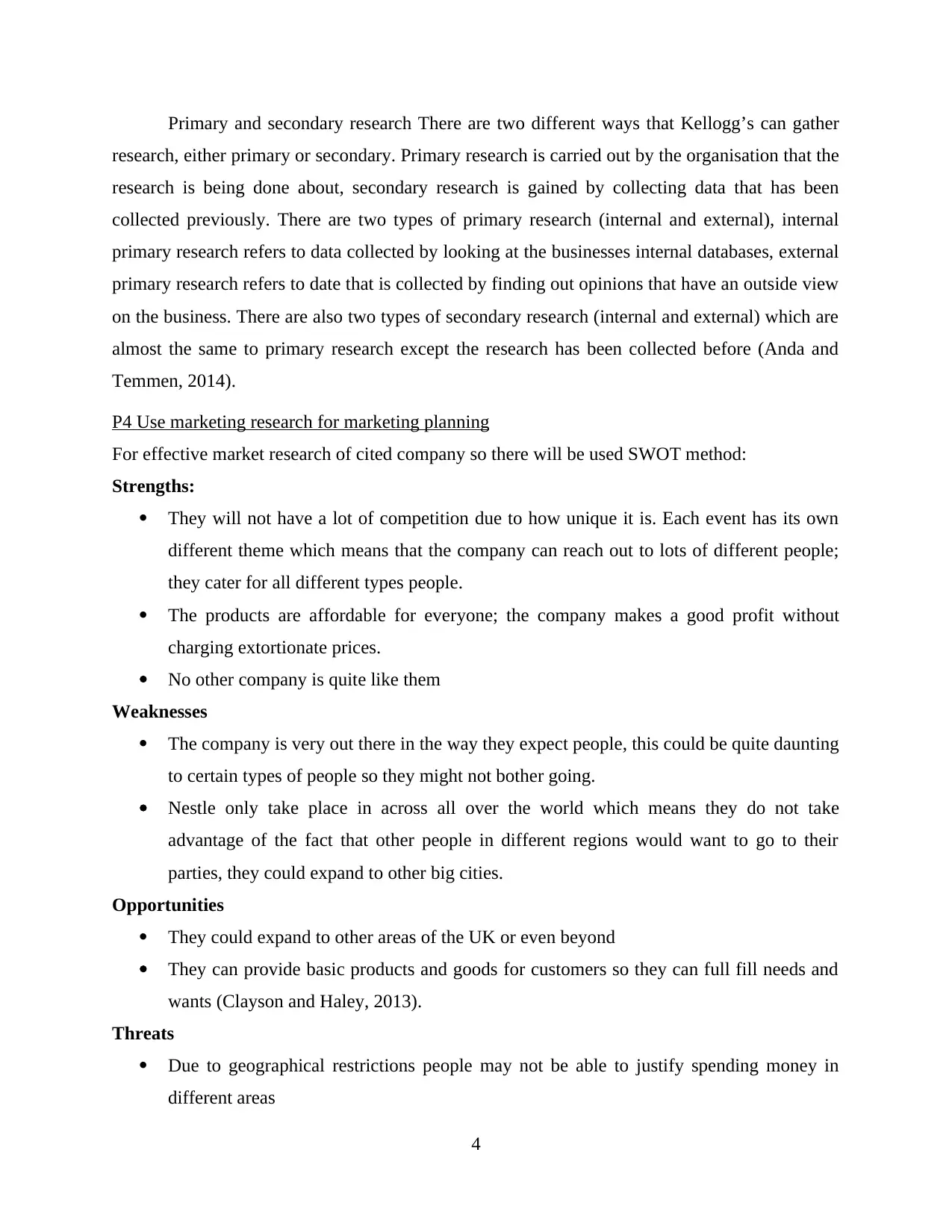
Primary and secondary research There are two different ways that Kellogg’s can gather
research, either primary or secondary. Primary research is carried out by the organisation that the
research is being done about, secondary research is gained by collecting data that has been
collected previously. There are two types of primary research (internal and external), internal
primary research refers to data collected by looking at the businesses internal databases, external
primary research refers to date that is collected by finding out opinions that have an outside view
on the business. There are also two types of secondary research (internal and external) which are
almost the same to primary research except the research has been collected before (Anda and
Temmen, 2014).
P4 Use marketing research for marketing planning
For effective market research of cited company so there will be used SWOT method:
Strengths:
They will not have a lot of competition due to how unique it is. Each event has its own
different theme which means that the company can reach out to lots of different people;
they cater for all different types people.
The products are affordable for everyone; the company makes a good profit without
charging extortionate prices.
No other company is quite like them
Weaknesses
The company is very out there in the way they expect people, this could be quite daunting
to certain types of people so they might not bother going.
Nestle only take place in across all over the world which means they do not take
advantage of the fact that other people in different regions would want to go to their
parties, they could expand to other big cities.
Opportunities
They could expand to other areas of the UK or even beyond
They can provide basic products and goods for customers so they can full fill needs and
wants (Clayson and Haley, 2013).
Threats
Due to geographical restrictions people may not be able to justify spending money in
different areas
4
research, either primary or secondary. Primary research is carried out by the organisation that the
research is being done about, secondary research is gained by collecting data that has been
collected previously. There are two types of primary research (internal and external), internal
primary research refers to data collected by looking at the businesses internal databases, external
primary research refers to date that is collected by finding out opinions that have an outside view
on the business. There are also two types of secondary research (internal and external) which are
almost the same to primary research except the research has been collected before (Anda and
Temmen, 2014).
P4 Use marketing research for marketing planning
For effective market research of cited company so there will be used SWOT method:
Strengths:
They will not have a lot of competition due to how unique it is. Each event has its own
different theme which means that the company can reach out to lots of different people;
they cater for all different types people.
The products are affordable for everyone; the company makes a good profit without
charging extortionate prices.
No other company is quite like them
Weaknesses
The company is very out there in the way they expect people, this could be quite daunting
to certain types of people so they might not bother going.
Nestle only take place in across all over the world which means they do not take
advantage of the fact that other people in different regions would want to go to their
parties, they could expand to other big cities.
Opportunities
They could expand to other areas of the UK or even beyond
They can provide basic products and goods for customers so they can full fill needs and
wants (Clayson and Haley, 2013).
Threats
Due to geographical restrictions people may not be able to justify spending money in
different areas
4
⊘ This is a preview!⊘
Do you want full access?
Subscribe today to unlock all pages.

Trusted by 1+ million students worldwide
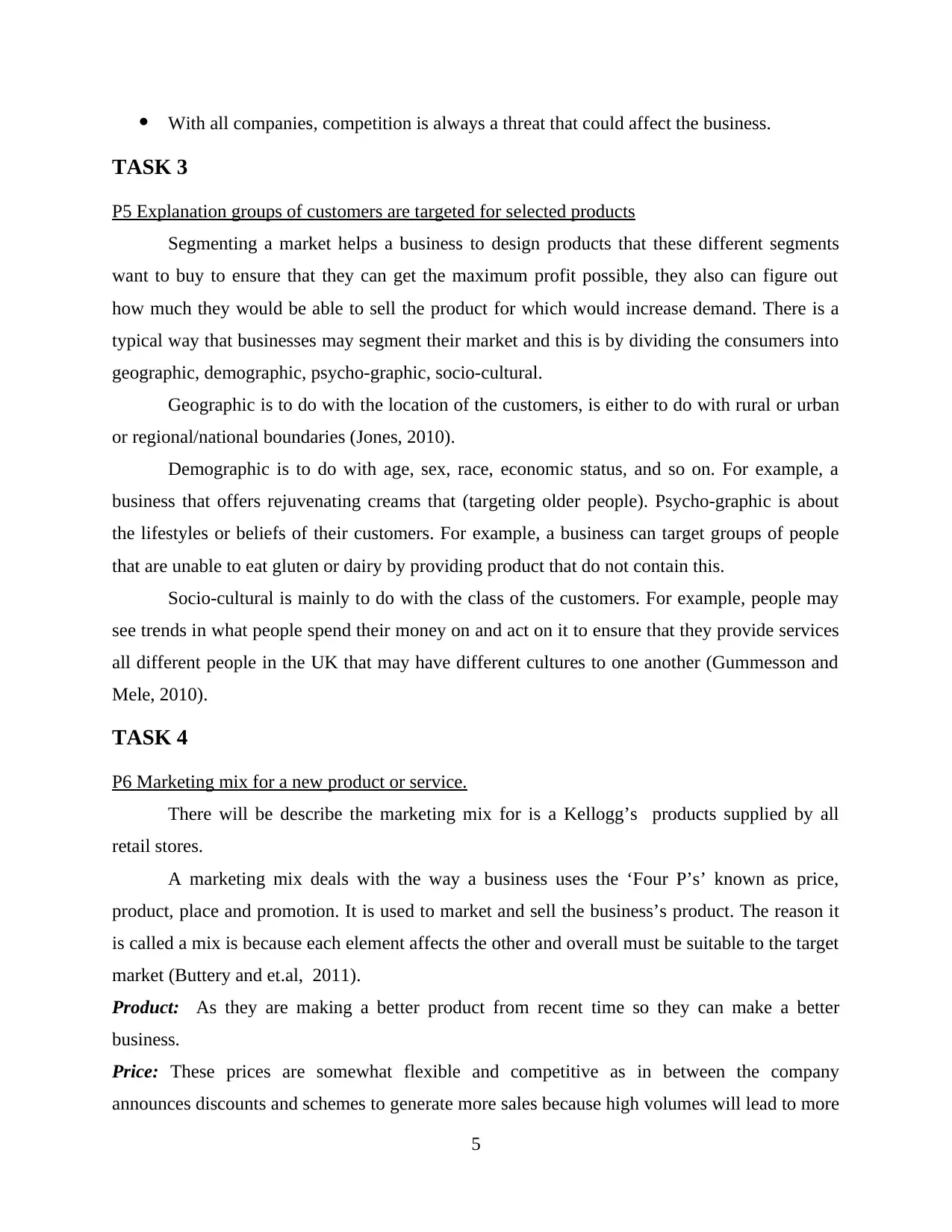
With all companies, competition is always a threat that could affect the business.
TASK 3
P5 Explanation groups of customers are targeted for selected products
Segmenting a market helps a business to design products that these different segments
want to buy to ensure that they can get the maximum profit possible, they also can figure out
how much they would be able to sell the product for which would increase demand. There is a
typical way that businesses may segment their market and this is by dividing the consumers into
geographic, demographic, psycho-graphic, socio-cultural.
Geographic is to do with the location of the customers, is either to do with rural or urban
or regional/national boundaries (Jones, 2010).
Demographic is to do with age, sex, race, economic status, and so on. For example, a
business that offers rejuvenating creams that (targeting older people). Psycho-graphic is about
the lifestyles or beliefs of their customers. For example, a business can target groups of people
that are unable to eat gluten or dairy by providing product that do not contain this.
Socio-cultural is mainly to do with the class of the customers. For example, people may
see trends in what people spend their money on and act on it to ensure that they provide services
all different people in the UK that may have different cultures to one another (Gummesson and
Mele, 2010).
TASK 4
P6 Marketing mix for a new product or service.
There will be describe the marketing mix for is a Kellogg’s products supplied by all
retail stores.
A marketing mix deals with the way a business uses the ‘Four P’s’ known as price,
product, place and promotion. It is used to market and sell the business’s product. The reason it
is called a mix is because each element affects the other and overall must be suitable to the target
market (Buttery and et.al, 2011).
Product: As they are making a better product from recent time so they can make a better
business.
Price: These prices are somewhat flexible and competitive as in between the company
announces discounts and schemes to generate more sales because high volumes will lead to more
5
TASK 3
P5 Explanation groups of customers are targeted for selected products
Segmenting a market helps a business to design products that these different segments
want to buy to ensure that they can get the maximum profit possible, they also can figure out
how much they would be able to sell the product for which would increase demand. There is a
typical way that businesses may segment their market and this is by dividing the consumers into
geographic, demographic, psycho-graphic, socio-cultural.
Geographic is to do with the location of the customers, is either to do with rural or urban
or regional/national boundaries (Jones, 2010).
Demographic is to do with age, sex, race, economic status, and so on. For example, a
business that offers rejuvenating creams that (targeting older people). Psycho-graphic is about
the lifestyles or beliefs of their customers. For example, a business can target groups of people
that are unable to eat gluten or dairy by providing product that do not contain this.
Socio-cultural is mainly to do with the class of the customers. For example, people may
see trends in what people spend their money on and act on it to ensure that they provide services
all different people in the UK that may have different cultures to one another (Gummesson and
Mele, 2010).
TASK 4
P6 Marketing mix for a new product or service.
There will be describe the marketing mix for is a Kellogg’s products supplied by all
retail stores.
A marketing mix deals with the way a business uses the ‘Four P’s’ known as price,
product, place and promotion. It is used to market and sell the business’s product. The reason it
is called a mix is because each element affects the other and overall must be suitable to the target
market (Buttery and et.al, 2011).
Product: As they are making a better product from recent time so they can make a better
business.
Price: These prices are somewhat flexible and competitive as in between the company
announces discounts and schemes to generate more sales because high volumes will lead to more
5
Paraphrase This Document
Need a fresh take? Get an instant paraphrase of this document with our AI Paraphraser
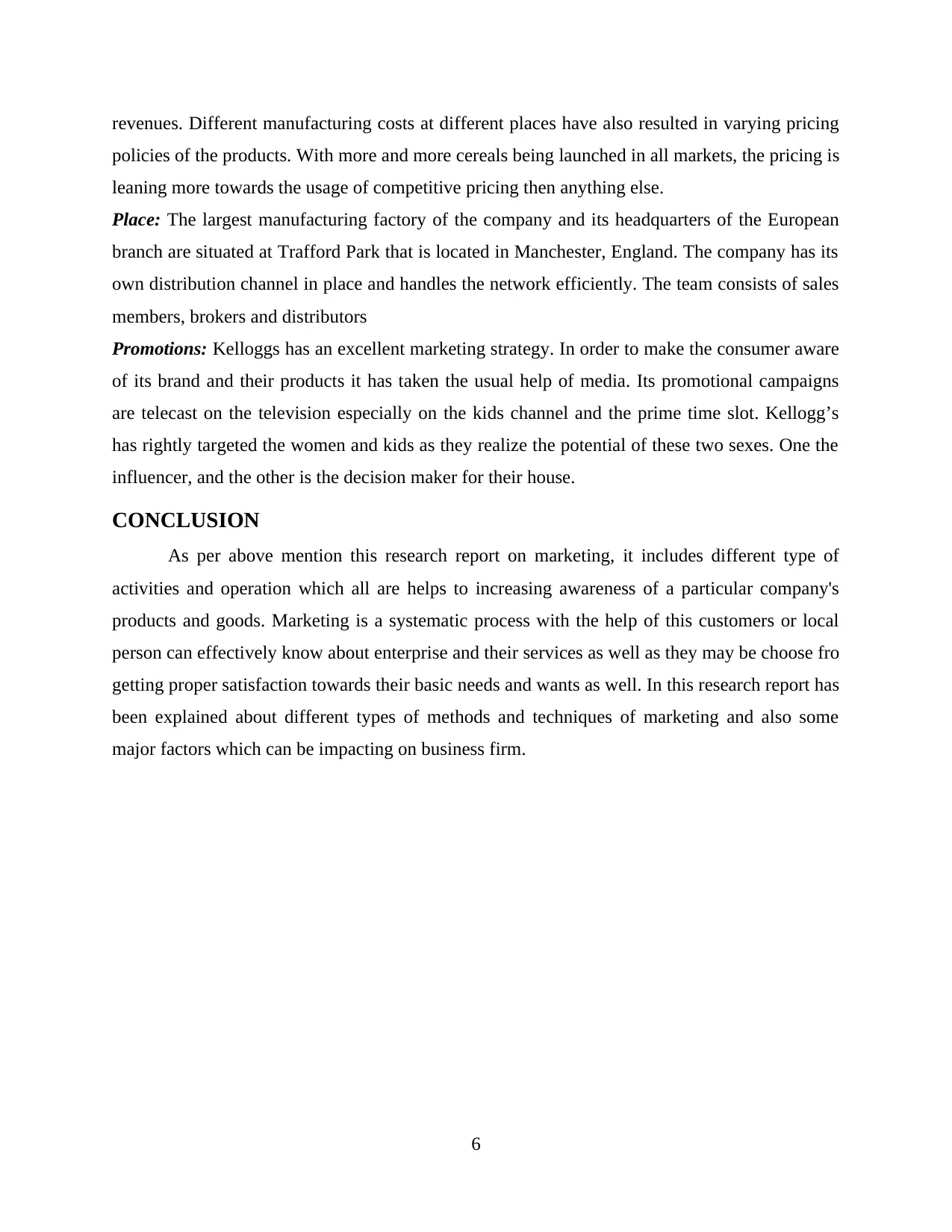
revenues. Different manufacturing costs at different places have also resulted in varying pricing
policies of the products. With more and more cereals being launched in all markets, the pricing is
leaning more towards the usage of competitive pricing then anything else.
Place: The largest manufacturing factory of the company and its headquarters of the European
branch are situated at Trafford Park that is located in Manchester, England. The company has its
own distribution channel in place and handles the network efficiently. The team consists of sales
members, brokers and distributors
Promotions: Kelloggs has an excellent marketing strategy. In order to make the consumer aware
of its brand and their products it has taken the usual help of media. Its promotional campaigns
are telecast on the television especially on the kids channel and the prime time slot. Kellogg’s
has rightly targeted the women and kids as they realize the potential of these two sexes. One the
influencer, and the other is the decision maker for their house.
CONCLUSION
As per above mention this research report on marketing, it includes different type of
activities and operation which all are helps to increasing awareness of a particular company's
products and goods. Marketing is a systematic process with the help of this customers or local
person can effectively know about enterprise and their services as well as they may be choose fro
getting proper satisfaction towards their basic needs and wants as well. In this research report has
been explained about different types of methods and techniques of marketing and also some
major factors which can be impacting on business firm.
6
policies of the products. With more and more cereals being launched in all markets, the pricing is
leaning more towards the usage of competitive pricing then anything else.
Place: The largest manufacturing factory of the company and its headquarters of the European
branch are situated at Trafford Park that is located in Manchester, England. The company has its
own distribution channel in place and handles the network efficiently. The team consists of sales
members, brokers and distributors
Promotions: Kelloggs has an excellent marketing strategy. In order to make the consumer aware
of its brand and their products it has taken the usual help of media. Its promotional campaigns
are telecast on the television especially on the kids channel and the prime time slot. Kellogg’s
has rightly targeted the women and kids as they realize the potential of these two sexes. One the
influencer, and the other is the decision maker for their house.
CONCLUSION
As per above mention this research report on marketing, it includes different type of
activities and operation which all are helps to increasing awareness of a particular company's
products and goods. Marketing is a systematic process with the help of this customers or local
person can effectively know about enterprise and their services as well as they may be choose fro
getting proper satisfaction towards their basic needs and wants as well. In this research report has
been explained about different types of methods and techniques of marketing and also some
major factors which can be impacting on business firm.
6
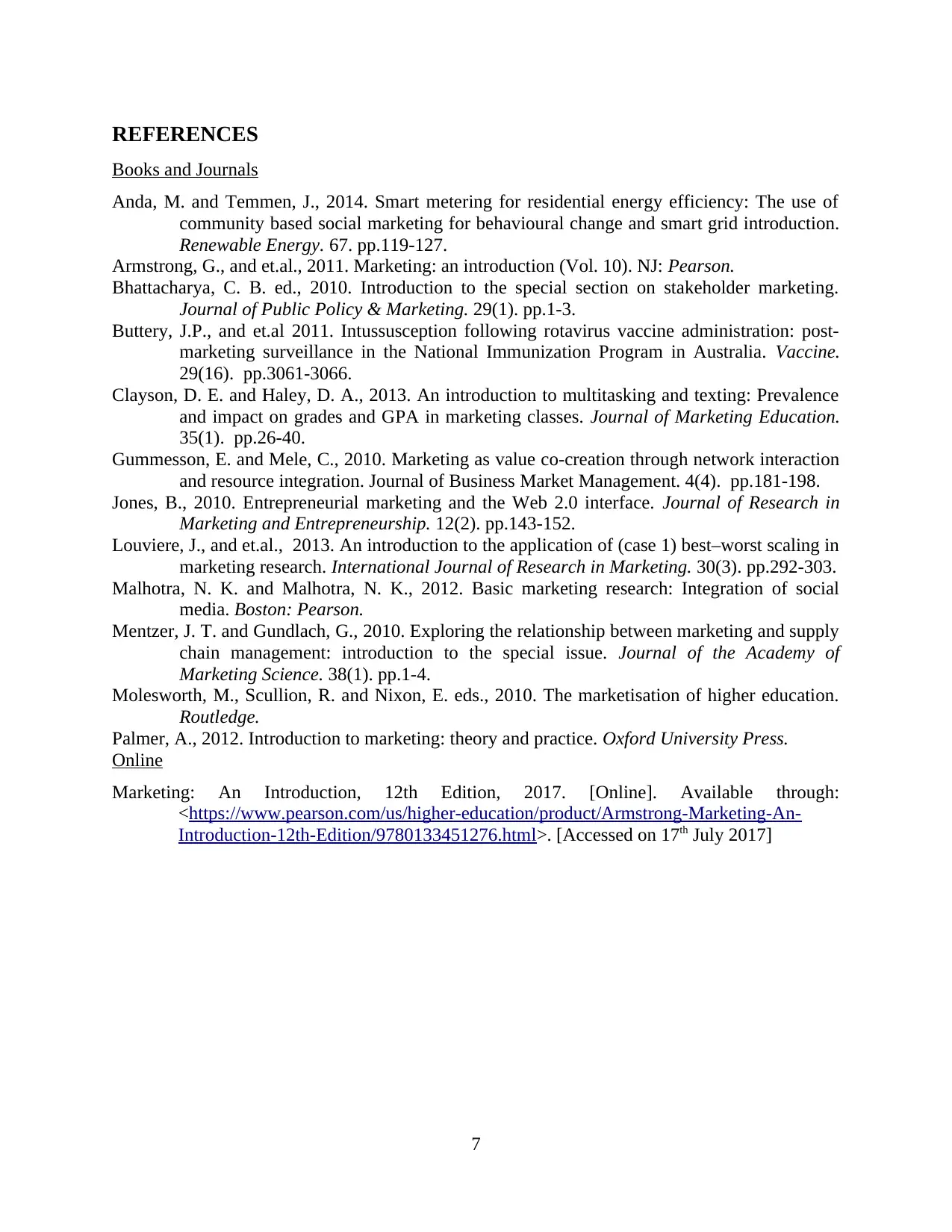
REFERENCES
Books and Journals
Anda, M. and Temmen, J., 2014. Smart metering for residential energy efficiency: The use of
community based social marketing for behavioural change and smart grid introduction.
Renewable Energy. 67. pp.119-127.
Armstrong, G., and et.al., 2011. Marketing: an introduction (Vol. 10). NJ: Pearson.
Bhattacharya, C. B. ed., 2010. Introduction to the special section on stakeholder marketing.
Journal of Public Policy & Marketing. 29(1). pp.1-3.
Buttery, J.P., and et.al 2011. Intussusception following rotavirus vaccine administration: post-
marketing surveillance in the National Immunization Program in Australia. Vaccine.
29(16). pp.3061-3066.
Clayson, D. E. and Haley, D. A., 2013. An introduction to multitasking and texting: Prevalence
and impact on grades and GPA in marketing classes. Journal of Marketing Education.
35(1). pp.26-40.
Gummesson, E. and Mele, C., 2010. Marketing as value co-creation through network interaction
and resource integration. Journal of Business Market Management. 4(4). pp.181-198.
Jones, B., 2010. Entrepreneurial marketing and the Web 2.0 interface. Journal of Research in
Marketing and Entrepreneurship. 12(2). pp.143-152.
Louviere, J., and et.al., 2013. An introduction to the application of (case 1) best–worst scaling in
marketing research. International Journal of Research in Marketing. 30(3). pp.292-303.
Malhotra, N. K. and Malhotra, N. K., 2012. Basic marketing research: Integration of social
media. Boston: Pearson.
Mentzer, J. T. and Gundlach, G., 2010. Exploring the relationship between marketing and supply
chain management: introduction to the special issue. Journal of the Academy of
Marketing Science. 38(1). pp.1-4.
Molesworth, M., Scullion, R. and Nixon, E. eds., 2010. The marketisation of higher education.
Routledge.
Palmer, A., 2012. Introduction to marketing: theory and practice. Oxford University Press.
Online
Marketing: An Introduction, 12th Edition, 2017. [Online]. Available through:
<https://www.pearson.com/us/higher-education/product/Armstrong-Marketing-An-
Introduction-12th-Edition/9780133451276.html>. [Accessed on 17th July 2017]
7
Books and Journals
Anda, M. and Temmen, J., 2014. Smart metering for residential energy efficiency: The use of
community based social marketing for behavioural change and smart grid introduction.
Renewable Energy. 67. pp.119-127.
Armstrong, G., and et.al., 2011. Marketing: an introduction (Vol. 10). NJ: Pearson.
Bhattacharya, C. B. ed., 2010. Introduction to the special section on stakeholder marketing.
Journal of Public Policy & Marketing. 29(1). pp.1-3.
Buttery, J.P., and et.al 2011. Intussusception following rotavirus vaccine administration: post-
marketing surveillance in the National Immunization Program in Australia. Vaccine.
29(16). pp.3061-3066.
Clayson, D. E. and Haley, D. A., 2013. An introduction to multitasking and texting: Prevalence
and impact on grades and GPA in marketing classes. Journal of Marketing Education.
35(1). pp.26-40.
Gummesson, E. and Mele, C., 2010. Marketing as value co-creation through network interaction
and resource integration. Journal of Business Market Management. 4(4). pp.181-198.
Jones, B., 2010. Entrepreneurial marketing and the Web 2.0 interface. Journal of Research in
Marketing and Entrepreneurship. 12(2). pp.143-152.
Louviere, J., and et.al., 2013. An introduction to the application of (case 1) best–worst scaling in
marketing research. International Journal of Research in Marketing. 30(3). pp.292-303.
Malhotra, N. K. and Malhotra, N. K., 2012. Basic marketing research: Integration of social
media. Boston: Pearson.
Mentzer, J. T. and Gundlach, G., 2010. Exploring the relationship between marketing and supply
chain management: introduction to the special issue. Journal of the Academy of
Marketing Science. 38(1). pp.1-4.
Molesworth, M., Scullion, R. and Nixon, E. eds., 2010. The marketisation of higher education.
Routledge.
Palmer, A., 2012. Introduction to marketing: theory and practice. Oxford University Press.
Online
Marketing: An Introduction, 12th Edition, 2017. [Online]. Available through:
<https://www.pearson.com/us/higher-education/product/Armstrong-Marketing-An-
Introduction-12th-Edition/9780133451276.html>. [Accessed on 17th July 2017]
7
⊘ This is a preview!⊘
Do you want full access?
Subscribe today to unlock all pages.

Trusted by 1+ million students worldwide
1 out of 9
Related Documents
Your All-in-One AI-Powered Toolkit for Academic Success.
+13062052269
info@desklib.com
Available 24*7 on WhatsApp / Email
![[object Object]](/_next/static/media/star-bottom.7253800d.svg)
Unlock your academic potential
Copyright © 2020–2025 A2Z Services. All Rights Reserved. Developed and managed by ZUCOL.





